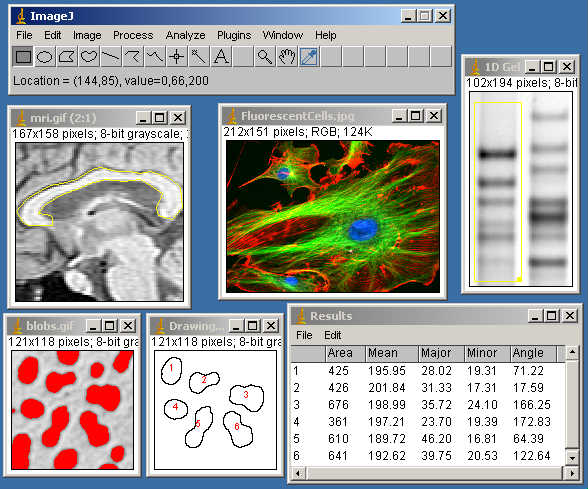ImageJ is a Java based image processing application that can display, edit, analyze process, save and print 8-bit, 16-bit and 32-bit images. It can read many image formats including TIFF, GIF, JPEG, BMP, DICOM, FITS and “raw”. It supports “stacks”, a series of images that share a single window. It is multithreaded, so time-consuming operations such as image file reading can be performed in parallel with other operations.
It can calculate area and pixel value statistics of user-defined selections. It can measure distances and angles. It can create density histograms and line profile plots. It supports standard image processing functions such as contrast manipulation, sharpening, smoothing, edge detection and median filtering.
It does geometric transformations such as scaling, rotation and flips. Image can be zoomed up to 32:1 and down to 1:32. All analysis and processing functions are available at any magnification factor. The program supports any number of windows (images) simultaneously, limited only by available memory.
Spatial calibration is available to provide real world dimensional measurements in units such as millimeters. Density or gray scale calibration is also available.
ImageJ was designed with an open architecture that provides extensibility via Java plugins. Custom acquisition, analysis and processing plugins can be developed using ImageJ’s built in editor and Java compiler. User-written plugins make it possible to solve almost any image processing or analysis problem.
Features:
- Runs Everywhere: ImageJ runs on Linux, Mac OS 9, Mac OS X, Windows, and the Sharp Zaurus PDA.
- Open Source: ImageJ and its Java source code are freely available and in the public domain. No license is required.
- [advt]User Community: ImageJ has a large and knowledgeable worldwide user community. More than 1700 users and developers subscribe to the ImageJ mailing list.
- Macros: Automate tasks and create custom tools using macros. Automatically generate macro code using the command recorder. More than 300 macros are available on the ImageJ Web site.
- Plugins: Extend ImageJ by developing plugins using ImageJ’s built in text editor and Java compiler. More than 500 plugins are available.
- Toolkit: Use ImageJ as a image processing toolkit (class library) to develop applets, servlets or applications.
- Speed: ImageJ is the world’s fastest pure Java image processing program. It can filter a 2048×2048 image in 0.1 seconds (*). That’s 40 million pixels per second!
- Data Types: 8-bit grayscale or indexed color, 16-bit unsigned integer, 32-bit floating-point and RGB color.
- File Formats: Open and save all supported data types as TIFF (uncompressed) or as raw data. Open and save GIF, JPEG, BMP, PNG, PGM, FITS and ASCII. Open DICOM. Open TIFFs, GIFs, JPEGs, DICOMs and raw data using a URL. Open and save many other formats using plugins.
- Image display: Tools are provided for zooming (1:32 to 32:1) and scrolling images. All analysis and processing functions work at any magnification factor.
- Selections: Create rectangular, elliptical or irregular area selections. Create line and point selections. Edit selectoins and automatically create them using the wand tool. Draw, fill, clear, filter or measure selections. Save selections and transer them to other images.
- Image Enhancement: Supports smoothing, sharpening, edge detection, median filtering and thresholding on both 8-bit grayscale and RGB color images. Interactively adjust brightness and contrast of 8, 16 and 32-bit images.
- Geometric Operations: Crop, scale, resize and rotate. Flip vertically or horizontally.
- Analysis: Measure area, mean, standard deviation, min and max of selection or entire image. Measure lengths and angles. Use real world measurement units such as millimeters.



Be the first to comment